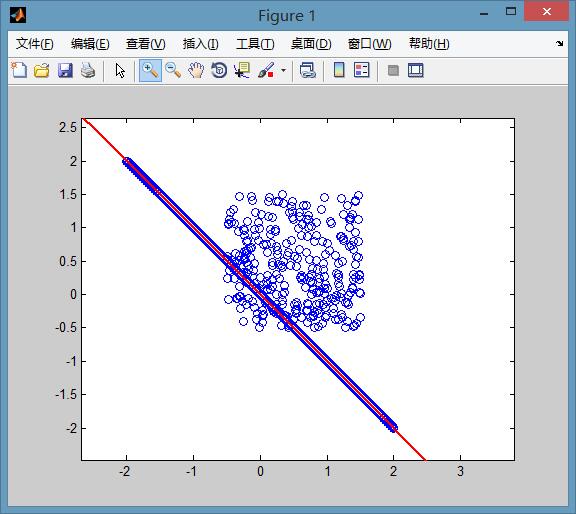目录
- 算法介绍
- 举例
- 算法的基本思想和流程
- 算法的实现流程:
- 迭代次数的推导
- 算法的实现
- python代码实现
- References
算法介绍
首先我们从Random sample consensus - Wikipedia上找到RANSAC原理的介绍。
RANSAC算法的中文名称是随机抽样一致算法(Random Sample Consenus),简单的说,通过RANSAC算法,我们将数据分为inliers和outliers,inliers是对于模型拟合有效的点,也称之为内点;outliers是对于模型拟合无效的点,也就是错误的数据点,称之为外点。而我们在使用观测数据拟合模型的过程中,外点的存在对于使用数据拟合模型是有害的,那么我们该如何剔除这些外点呢?RANSAC算法就是能够剔除外点的一个迭代性的算法。
举例
下图所示就是RANSAC算法的作用:剔除外点,使模型估计更加准确,参考Robust line model estimation using RANSAC — skimage v0.19.2 docs (scikit-image.org)

算法的基本思想和流程
算法的实现流程:
- 选择出估计模型的最小数据样本(对于二维和三维直线拟合来说,确定一条直线最少需要2个点;对于三维平面拟合来说,确定一个三维平面最少需要3个点)
- 使用这个最小的数据样本,算出拟合的模型。(也就是直线方程或者平面方程)
- 将所有的模型带入这个拟合的模型,计算出内点 的数量。(数据点和拟合的模型的误差在一定阈值范围内的数据点的数量)
- 比较当前模型和之前迭代的得到的最好的模型的内点数量(内点数量越多,模型越好),记录最大的内点数的模型参数和内点数量。
- 重复1-4步,直到达到迭代终止条件(例如达到最大迭代数、内点数量达到迭代终止条件)
迭代次数的推导
假设内点在数据中所占的比例为 t t t
t = n i n l i e r s n i n l i e r s + n o u t l i e r s t=\frac{n_{inliers}}{n_{inliers}+n_{outliers}} t=ninliers+noutliersninliers
如果我们每次迭代都需要 N N N个点,那么每次迭代至少有一个外点的概率是:
P 1 = 1 − t N P_{1}=1-t^N P1=1−tN
那么我们如果迭代 k k k次,所有的 k k k次迭代都至少有一个外点的概率为 P 1 k P_{1}^{k} P1k,那么这 k k k次迭代,能够采样到正确的 N N N个内点去计算模型的概率就是上述概率的补集。
P = 1 − P 1 k = 1 − ( 1 − t N ) k P=1-P_{1}^{k}=1-(1-t^{N})^{k} P=1−P1k=1−(1−tN)k
通过上式,我们可以求得
k = l o g ( 1 − P ) l o g ( 1 − t N ) k=\frac{log(1-P)}{log(1-t^{N})} k=log(1−tN)log(1−P)
注意:内点的概率 t t t是一个先验值,如果我们一开始不知道这个先验值 t t t,可以采用自适应迭代的方法,用当前的内点的比值来当成 t t t来估算迭代的次数。然后通过不断迭代,内点的比值也逐渐增大,再用新的更大的内点比值去代替 t t t的值;对于 P P P来说,一般会取一个定值0.99,等式(4)可以看出,当 P P P不变时, t t t越大, k k k越小, t t t越小, k k k越大。
算法的实现
Given:data – A set of observations.model – A model to explain observed data points.n – Minimum number of data points required to estimate model parameters.k – Maximum number of iterations allowed in the algorithm.t – Threshold value to determine data points that are fit well by model.d – Number of close data points required to assert that a model fits well to data.Return:bestFit – model parameters which best fit the data (or null if no good model is found)iterations = 0
bestFit = null
bestErr = something really largewhile iterations < k domaybeInliers := n randomly selected values from datamaybeModel := model parameters fitted to maybeInliersalsoInliers := empty setfor every point in data not in maybeInliers doif point fits maybeModel with an error smaller than tadd point to alsoInliersend ifend forif the number of elements in alsoInliers is > d then// This implies that we may have found a good model// now test how good it is.betterModel := model parameters fitted to all points in maybeInliers and alsoInliersthisErr := a measure of how well betterModel fits these pointsif thisErr < bestErr thenbestFit := betterModelbestErr := thisErrend ifend ifincrement iterations
end whilereturn bestFit
python代码实现
以下代码参考scikit-image/fit.py at v0.19.2 · scikit-image/scikit-image (github.com),也就是skimage的源码。
def _dynamic_max_trials(n_inliers, n_samples, min_samples, probability):if n_inliers == 0:return np.infif probability == 1:return np.infif n_inliers == n_samples:return 1nom = math.log(1 - probability)denom = math.log(1 - (n_inliers / n_samples) ** min_samples)return int(np.ceil(nom / denom))def ransac(data, model_class, min_samples, residual_threshold,is_data_valid=None, is_model_valid=None,max_trials=100, stop_sample_num=np.inf, stop_residuals_sum=0,stop_probability=1, random_state=None, initial_inliers=None):best_inlier_num = 0best_inlier_residuals_sum = np.infbest_inliers = []validate_model = is_model_valid is not Nonevalidate_data = is_data_valid is not Nonerandom_state = np.random.default_rng(random_state)# in case data is not pair of input and output, male it like itif not isinstance(data, (tuple, list)):data = (data, )num_samples = len(data[0])if not (0 < min_samples < num_samples):raise ValueError(f"`min_samples` must be in range (0, {num_samples})")if residual_threshold < 0:raise ValueError("`residual_threshold` must be greater than zero")if max_trials < 0:raise ValueError("`max_trials` must be greater than zero")if not (0 <= stop_probability <= 1):raise ValueError("`stop_probability` must be in range [0, 1]")if initial_inliers is not None and len(initial_inliers) != num_samples:raise ValueError(f"RANSAC received a vector of initial inliers (length "f"{len(initial_inliers)}) that didn't match the number of "f"samples ({num_samples}). The vector of initial inliers should "f"have the same length as the number of samples and contain only "f"True (this sample is an initial inlier) and False (this one "f"isn't) values.")# for the first run use initial guess of inliersspl_idxs = (initial_inliers if initial_inliers is not Noneelse random_state.choice(num_samples, min_samples,replace=False))# estimate model for current random sample setmodel = model_class()for num_trials in range(max_trials):# do sample selection according data pairssamples = [d[spl_idxs] for d in data]# for next iteration choose random sample set and be sure that# no samples repeatspl_idxs = random_state.choice(num_samples, min_samples, replace=False)# optional check if random sample set is validif validate_data and not is_data_valid(*samples):continuesuccess = model.estimate(*samples)# backwards compatibilityif success is not None and not success:continue# optional check if estimated model is validif validate_model and not is_model_valid(model, *samples):continueresiduals = np.abs(model.residuals(*data))# consensus set / inliersinliers = residuals < residual_thresholdresiduals_sum = residuals.dot(residuals)# choose as new best model if number of inliers is maximalinliers_count = np.count_nonzero(inliers)if (# more inliersinliers_count > best_inlier_num# same number of inliers but less "error" in terms of residualsor (inliers_count == best_inlier_numand residuals_sum < best_inlier_residuals_sum)):best_inlier_num = inliers_countbest_inlier_residuals_sum = residuals_sumbest_inliers = inliersdynamic_max_trials = _dynamic_max_trials(best_inlier_num,num_samples,min_samples,stop_probability)if (best_inlier_num >= stop_sample_numor best_inlier_residuals_sum <= stop_residuals_sumor num_trials >= dynamic_max_trials):break# estimate final model using all inliersif any(best_inliers):# select inliers for each data arraydata_inliers = [d[best_inliers] for d in data]model.estimate(*data_inliers)if validate_model and not is_model_valid(model, *data_inliers):warn("Estimated model is not valid. Try increasing max_trials.")else:model = Nonebest_inliers = Nonewarn("No inliers found. Model not fitted")return model, best_inliers
下一篇我们将重点讲解使用RANSAC拟合直线的例子,请移步RANSAC算法与原理(二)
References
Random sample consensus - Wikipedia
RANSAC算法详解(附Python拟合直线模型代码) - 知乎 (zhihu.com)
Robust line model estimation using RANSAC — skimage v0.19.2 docs (scikit-image.org)
scikit-image/fit.py at v0.19.2 · scikit-image/scikit-image (github.com)


















